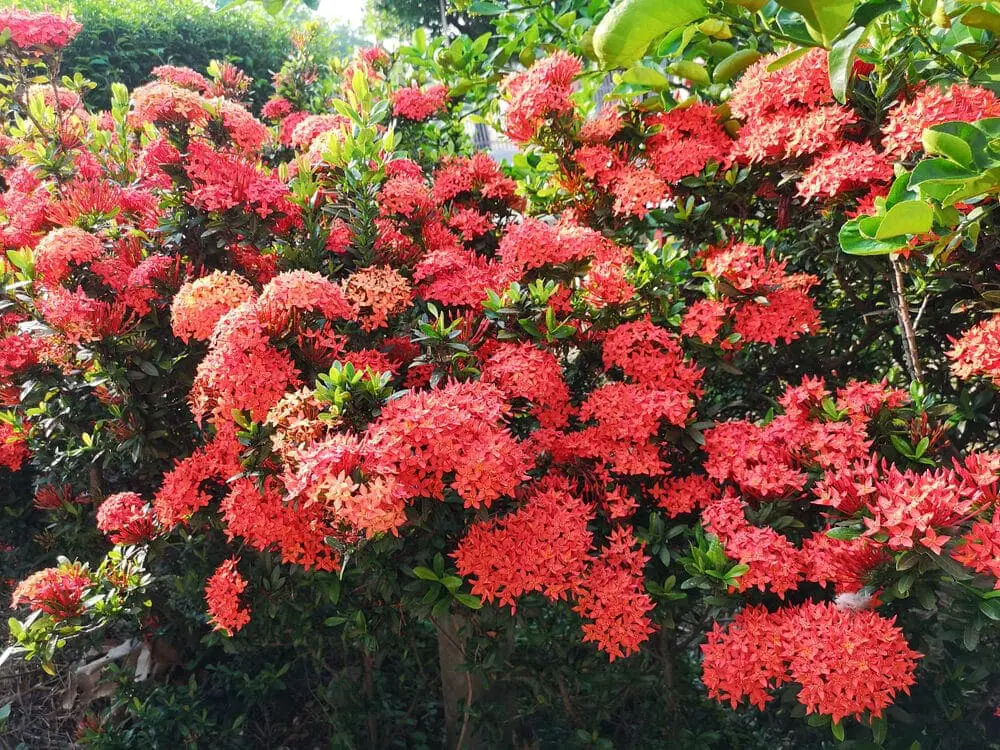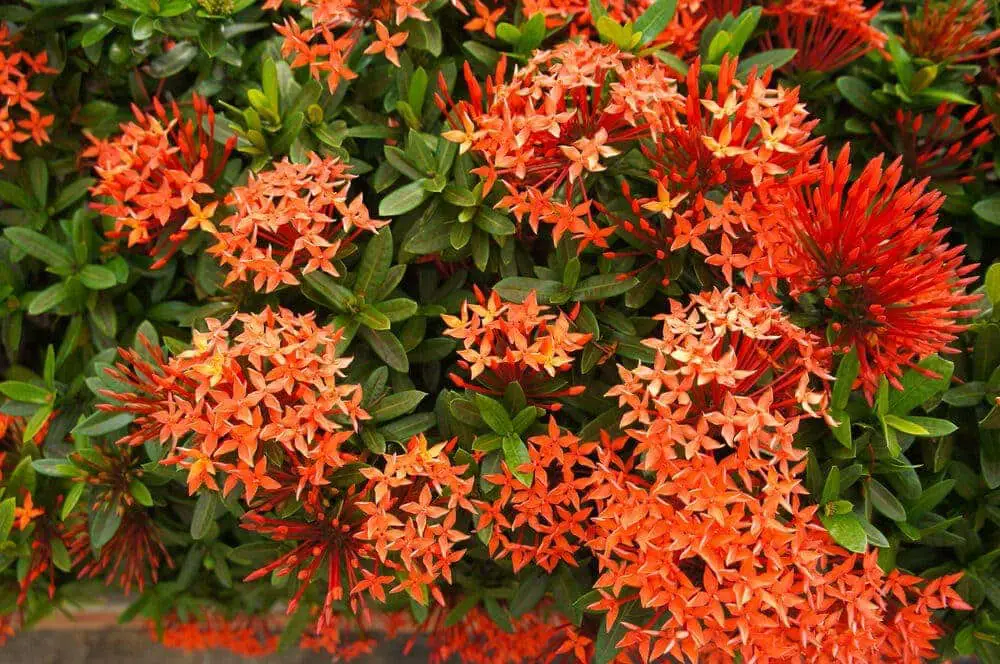This small but hardy plant can add a lot of color to your indoor plant collection or your garden outside.
It loves acidic soil and temperatures that don’t change widely. It can also make an excellent present for those wanting to start their own flower garden.
Dwarf Ixora Care & Growing Guide
1. Light requirements
The Dwarf Ixora enjoys at least six hours of both direct and indirect sunlight every day. The early morning sunlight should be the only time it receives direct sunlight. By noon it should be in the shade. It can also be placed under a partially shaded area, but it won’t happen as many flowers. If it is indoors, place it by a window that receives a lot of bright light.
2. Water
Be careful not to overwater this plant. The ground soil needs to stay moist but not damp, but do not let the soil near its roots dry out. Because of its shallow roots, you can test the moisture by sticking your finger in the soil. Soak it thoroughly once a week, but during the winter, cut back and water it only when the topsoil is dry.
3. Climate and temperatures
The dwarf Ixora likes to be in warm temperatures. It also wants to be in mild humidity, but it does not like it’s leaves to be wet. It commonly grows in a hardiness zone of 10 or 11. If this plant is exposed to a sudden cold wave, the leaves will fall off of their stems. 65 to 70 degrees F is the perfect temperature for this plant.
4. Soil
The dwarf Ixora thrives when it’s in slightly acidic soil, with a pH of 5. The soil below its roots has to drain out water quickly but also stay moist. If it is in a container indoors, the soil must remain moist too. To increase the acidity of the soil or potting mix, you can add peat moss.
5. Repotting
When you are switching the dwarf Ixora to a new pot, make sure it is not much better than the old one. You should repot this plant every two to three years, or when its roots overgrow. Move the dwarf plant to a pot that is one to two inches bigger than the original.

6. How to propagate the Dwarf Ixora?
Propagation of this plant is difficult, and it may not work in most cases. Cut a piece of the stem off and bury it in potting soil that promotes root growth. Start the cutting off in a small pot, and it should root in about two weeks.
7. Height and spread
Because of its snail-like growth, this plant usually reaches just up to two to three feet tall, but its width can grow up to four feet. It is generally planted to make a border or hedge around a section of a garden.
8. Trimming
If you want to trim the dwarf plant, you should prune it after the first freeze if you reside in a cold area. First, trim branches and leaves that have frost damage. Then, trim the branches that have three prongs on them. Many people trim this plant into a shape, like a square. When you’re finished, don’t water it for a week, then resume regular watering.
9. Does the Dwarf Ixora have flowers, and how do I help them bloom?
Yes, the dwarf Ixora plant is known for its bright red flowers that grow in clusters. But the flowers also come in yellow, pink or orange. The flower buds are right on top of the tips of the stems, so if you trim the plants a lot, you could be cutting off the bulb. Also, this plant needs to be in full and indirect sunlight, and the soil needs to be around five pH, which is acidic.

Is the Dwarf Ixora poisonous?
No, the Dwarf Ixora is not poisonous to either animals or human beings. It cannot be eaten as it’s not fit for human consumption.
Can plants grow in water?
No, the Dwarf Ixora cannot be grown in water. The roots don’t like to be overwatered, so it will die quickly if the plant has to root itself in wet soil.
Also read: Haworthia Cooperi Care & Growing Guide
Common Plant Diseases and pests
Aphids are one of the worst insects that the Dwarf Ixora can experience. If you have aphids on or under its leaves, you can kill them by spraying the entire plant with insecticide soap. Do this every few days until there are no more aphids.
Sooty mold is a black fungus that is created by certain insects when those insects eat parts of the plant that they’re on. It is very sticky and many insects track this mold all over the plant. Sooty mold doesn’t kill your plant, but it does make it look hideous. To get rid of sooty mold, you must spray the dwarf plant with neem oil or a neem wash. This spray forces the bugs, which make the sooty mold, leave, and then the mold can be removed with a hose or in a sink.
Leaf Spot is a fungal disease that infects the leaves of a plant and changes its color to yellow. This fungus is not fatal itself, but if enough leaves developed yellow spots, then those leaves cannot perform photosynthesis. The spore of the leaf spot fungus travels in the air and land where it is warm and wet. To stop leaf spot from killing your plant, you have to remove all of the leaves that have the yellow spots first. After that, spray the whole plant with a fungicide. Do not water the dwarf plant until it needs water.
Similar post: Sansevieria Moonshine Care & Growing Guide
Conclusion
- Dwarf ixoras don’t have many insect enemies expect aphids.
- This plan is part of the coffee family.
- Five pH is the ideal soil for this plant.
- If you trim this plant before the first frost, the flowers may not bloom in the spring.
- It is originally from South Asia.
- Its scientific name is Ixora taiwanensis.
- The less sunlight it receives, the fewer flowers it will have.
- Despite how small the flowers are, they have a very fragrant scent.
Victoria is the owner and main author of hobby plants. She loves spending her free time in her garden planting and taking care of her plants. Victoria hopes you enjoy the content here!
![Mother Of Thousands Plant [Complete Plant Care Guide] Mother Of Thousands Plant [Complete Plant Care Guide]](https://www.hobbyplants.com/wp-content/uploads/2022/07/mother-of-thousands-plant-300x158.jpg)
![Majesty Palm Plant Care: [Complete Beginner's Guide] Majesty Palm Plant Care: [Complete Beginner's Guide]](https://www.hobbyplants.com/wp-content/uploads/2022/08/majesty-palm-care-300x158.jpg)
![Exotic Angel Plant Care: [Complete Beginner's Guide] Exotic Angel Plant Care: [Complete Beginner's Guide]](https://www.hobbyplants.com/wp-content/uploads/2022/08/exotic-angel-plant-care-300x158.jpg)
![Snow White Waffle Plant: [Complete Care Guide] Snow White Waffle Plant: [Complete Care Guide]](https://www.hobbyplants.com/wp-content/uploads/2022/08/snow-white-waffle-plant-300x158.jpg)
![Waffle Plant Care: [Complete Beginner's Guide] Waffle Plant Care: [Complete Beginner's Guide]](https://www.hobbyplants.com/wp-content/uploads/2022/08/waffle-plant-300x158.jpg)
![Bird Of Paradise Plant Care: [Complete Beginner's Guide] Bird Of Paradise Plant Care: [Complete Beginner's Guide]](https://www.hobbyplants.com/wp-content/uploads/2022/08/bird-of-paradise-plant-300x158.jpg)
![Purple Passion Plant Care: [Complete Beginner's Guide] Purple Passion Plant Care: [Complete Beginner's Guide]](https://www.hobbyplants.com/wp-content/uploads/2022/08/purple-passion-plant-care-300x158.jpg)
![China Doll Plant Care: [Complete Beginner's Guide] China Doll Plant Care: [Complete Beginner's Guide]](https://www.hobbyplants.com/wp-content/uploads/2022/09/china-doll-plant-care-300x158.jpg)
![Polka Dot Plant Care: [Complete Beginner's Guide] Polka Dot Plant Care: [Complete Beginner's Guide]](https://www.hobbyplants.com/wp-content/uploads/2022/09/polka-dot-plant-300x158.jpg)
![Mona Lisa Lipstick Plant Care: [Complete Beginner's Guide] Mona Lisa Lipstick Plant Care: [Complete Beginner's Guide]](https://www.hobbyplants.com/wp-content/uploads/2022/09/lipstick-plant-mona-lisa-300x158.jpg)
![Yucca Cane Plant Care: [Complete Beginner's Guide] Yucca Cane Plant Care: [Complete Beginner's Guide]](https://www.hobbyplants.com/wp-content/uploads/2022/09/yucca-cane-plant-care-300x158.jpg)
![Bush On Fire Croton Plant Care: [Complete Beginner's Guide] Bush On Fire Croton Plant Care: [Complete Beginner's Guide]](https://www.hobbyplants.com/wp-content/uploads/2022/09/bush-on-fire-croton-300x158.jpg)